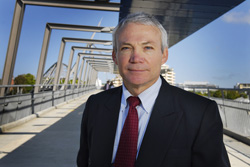2008 saw another productive and successful year for the CRC — an international conference delivered; awards won; numerous publications and indsutry kits produced, profiled and distributed; workshops across a broad range of subjects presented across the country; products launched; networks expanded and reinforced; new strategic relationships developed — outcomes that we have communicated throughout the year using print and online media, newsletters, the internet and through our participants.
One of our priorities for 2008 has been the development of a proposal for a new centre, for which we will be applying for CRC funding in 2009. The proposed Sustainable Built Environment centre offers an exciting opportunity to continue the momentum created by our existing CRC, but with a new research and education portfolio geared to emerging industry priorities across key areas of environmental, social and economic sustainability.
The change of government this year brought with it a review of the CRC Program. The report released by Senator Kim Carr, Federal Minister for Innovation, Industry, Science and Research, and led by Professor Mary O’Kane recommended that further funding be allocated to the Program. There was also a push to refocus the Program’s emphasis on public benefit from research. While we still await the release of the new CRC guidelines, indications are that their release is imminent.
There has been strong industry support for the proposed centre and the prospect of an exciting and powerful new partner group moving forward. Preliminary project proposals for the Sustainable Built Environment centre have been invited and the research and education activities that will form the strategic direction of the new centre are rapidly taking shape.
We can now confirm in-principle agreement to progress on two National Exemplar Projects and are working to secure another exemplar over the coming weeks. These high-profile, large-scale infrastructure and building projects will ensure that we are well-positioned to channel our applied research directly into practice for immediate and high-end impact on both industry and government policy priorities.
In Queensland, we’ll have the Gold Coast Light Rail Project stemming from the Gold Coast Rapid Transit project — a partnership between TransLink and the Gold Coast City Council. This integrated public transport network aims to increase the use of public transport on the Gold Coast in order to relieve traffic congestion.
Further south, the Victorian Schools Plan is an initiative to rebuild, renovate or extend 1600 schools by 2016. This project will engage the regions of Victoria in a program of sustainable construction and integrate future maintenance requirements into an intelligent asset system.
While I remain positive about the future of Australia’s construction industry, recent global events cannot be ignored. The full effects of the economic downturn are yet to be seen and, like many sectors, the construction industry is reacting with caution — projects are being reviewed and labour and training budgets reduced. This makes it all the more important to embrace the construction ideals of working better, faster, cheaper, safer and more sustainably. The timing of our proposed Sustainable Built Environment centre is opportune in this regard.
Our final projects as the CRC for Construction Innovation are due for completion this year and I’ll provide a brief overview of our plans for disseminating the outputs from this work in my last communication with you for 2008 in December.


